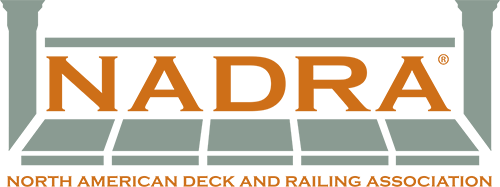By Glenn Mathewson
“Another public comment was also presented, one that could have a major impact on decking.“
How to build guards has never been provided for in the code, and even the loads that guards must resist have been pretty fuzzy throughout code history. Those target loads have come into some pretty serious question now that so much testing is being conducted to assure guard posts will meet a 500 lb or greater load. The current code requires the top of a guard and handrail to resist a 200 lb. load in any direction. Any direction means upward and inward, two directions that have nothing to do with a guard’s purpose, fall protection from an elevated surface. They do relate to a handrail’s purpose, to brace a fall in any direction and to assist in ascending or descending stairs or ramps.
The ASTM testing standards for composite rails and the ICC Evaluation Services acceptance criteria for other manufactured guards don’t exactly match the code, and the loads are questioned in all. This problem is well understood, yet meanwhile, proponents have been only narrowly defeated in the last two code modification cycles in their attempts to have prescriptive ands specific guard post connection details included in the IRC. It is the opinion of many others that the target loading and the direction of loading needs to be reevaluated and set more appropriately, before methods to meet the loads are solidified in code. That was the reason I, taking NADRA’s voice, attended the American Society of Civil Engineer’s (ASCE) Live and Dead Load Subcommittee meeting on November 7th, 2018.
The ASCE 7 standard is the nation’s go-to for establishing the minimum design loads for structures of all sorts. It’s generally the basis for the loads in the I-codes. So rather than attempt this change for guard loading at the ICC level, we went one level further in. The ASCE meeting was to review proposals and ideas for the next 2022 version of the ASCE 7 and proposals they are planning for the 2021 IBC development next year. The National Home Builders’ Association (NAHB), a friend to NADRA, led the charge with public comment proposals to the ASCE committee requesting guards and handrails be separated and their minimum loads and load directions be individually determined. While a handrail does need to resist a load in any direction, a guard does not. I spoke at the meeting in favor of the NAHB public comment and provided history of guard and handrails loads going back to the 1970. Over those years, guard and handrail minimum design loads were quite varied. On the west coast, under the Uniform Building Code, only a 20 lb. horizontal load applied 90 degrees to the guard, but on the east coast, under the Standard Building Code, it was 200 lb. in any direction. From the 70’s to 2000 IRC, guards underwent a lot of changes regarding design load, but still at that time guards weren’t tested by any more than a push from the inspector. Guards and handrail loads were combined, then separated, but then in later years combined again.
The history and the companion testimony at the meeting helped show the ASCE committee that indeed today’s design loads in the code and the ASCE standard are due for reevaluation. Before building the house of new deck codes, let’s make sure we have a good foundation. Alongside NADRA and the NAHB, the Stair Manufacturers’ Association and the Composite Lumber Manufacturers’ Association also provided insight into this much-needed reevaluation. The ASCE Committee agreed and affirmed a motion to work with the NAHB further on this issue. This was a great step in the right direction.
Though we attended the meeting for the guard discussion, there was more to learn. Code and standard proposals and recommendations can come from anyone. Being present and available to learn of those other proposals and to quickly respond is a very important part of representing an industry in code.
Another public comment was also presented, one that could have a major impact on decking. Stair treads are required to resist the familiar 40 psf live load that a deck surface must resist, but they also must resist a concentrated load of 300 lb. over a 4-square-inch area. This has to do with the impact from the balls of your feet while rapidly descending stairs. It has been in the codes for all stair treads since 1979. You may be familiar with composite decking stair tread span limitations. Due to this additional concentrated load, most composite decking has reduced allowable spans when used as stair treads. 16-inch on center joists for the deck, often have to be reduced to 12 inch or less on the stairs. A surprise proposal we were not expecting was to require the same stair tread concentrated load throughout the deck. Changing the minimum loading requirements, means re-proving that decking can meet the new loads, including the lumber decking spans brought into the code in 2015. If these changes were made, they would need to be with good justification and industry-wide evaluation.
The proponent argument for this proposal was in response to impact from stepping off ladders and known cases of deck board failure. What wasn’t shared is how many instances? How old was the decking? What was the condition? These were all questions posed by others in the room, as it is becoming well known that well-intended reactions to anecdotal instances have shaped a lot of recent codes. The very quick question I, we, NADRA, asked was why decks are being singled out and not all floor systems? If this is a human impact load on a floor surface, then what distinguishes the hazard between the floor inside the house and the deck? Why would the decking industry be singled out? Do we not use ladders inside the home? There was no solid answer to these questions and an affirmative motion to shelf the proposal and request more information and reason statements from the proponent.
Our efforts at this meeting have helped already to steer the future, but the winds are strong and the journey long. We need your support to stay involved in this critical work.




